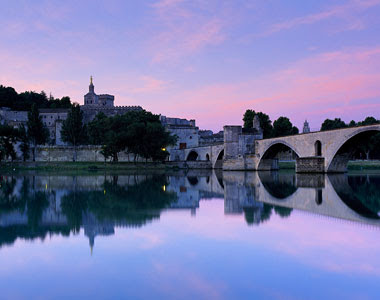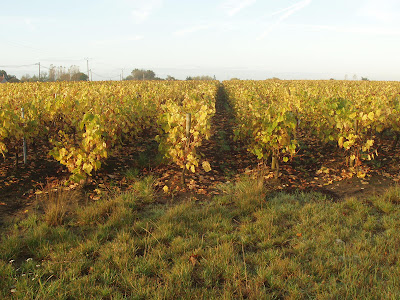
Aaaaah, the glamours of the wine business… After 8 hours in the air in a cramped tin can and a mad dash to the Montparnasse train station in Paris for my TGV, I finally made it to Nantes, near France’s Atlantic Coast. Luckily, I had taken into account the probabilities that we’d be delayed leaving NYC considering the current sorry state of flying in the US (high), and the chances of a strike occurring anywhere, anytime in France (ridiculously high). As it was, I barely missed the train, and having found my seat, I also discovered that I would remain caffeine- and food-free: the bar-car workers were on strike. Of course they were.
In any case, I was met at Nantes’ train station by Jean-Pascal Aubron, who’s Muscadet de Sèvre et Maine sur Lie I represent. The moment I sat in his car, I smiled: it smelled like wine, and that aroma lingered around Jean-Pascal as well. He gave me a quick tour of the city (quite pretty), then we headed out to Vallet (the ‘t’, usually silent, is pronounced in the regional dialect, apparently), a small town which houses about 10% of France’s Muscadet producers.
 The winery
The wineryAs in many other parts of the Loire Valley, the vineyards are very flat, with outcroppings of trees or villages to punctuate the landscape. It looked like a mottled yellow carpet, the Melon de Bourgogne vines’ leaves were all turning yellow with the cooler temperatures. Harvest had just ended, and the air had that unmistakable “winey” smell that all wine regions get when fermentation starts. I love that scent.
That night, I sat down for a tasting and dinner with Jean-Pascal and his wife. I was pleasantly surprised when Jean-Pascal generously brought out some older bottles of his Grand Fief de l’Audigère, as I had very little experience with older Muscadets. While it’s not enclosed or otherwise visibly demarcated, this vineyard has been recognized for the quality of its wines since the 1600s. The Aubrons tend 11 hectares (about 27.19 acres), and their family has been making wine in the area since the mid-19th century. While we tasted we munched on some lovely
rillettes de thon maison (shredded tuna paté, recipe to follow), and for dinner we enjoyed a
pot-au-feu (basically a slow-cooked stew of beef cheek and shank, with locally-grown carrots so sweet I swooned and melt-in-your mouth deliciously buttery potatoes) and an unassuming but delicious Bourgueuil (a local red made from Cab Franc).
The tasting started with a deliciously fresh and aromatic
2007, something I had been showing to my clients and which was the reason for my presence here. We moved on to a
2005 Grand Fief de L’Audigère Vieilles Vignes (an old-vine selection, something he only does in good vintages, from 40 year-old vines). This took a while to open up but when it did it was stunning, with a huge perfume and a beautifully lemony and briney taste on a fat but vibrant frame, with plenty of acidity to balance out the fruit. He then poured me a
2003, a vintage I am usually not fond of in Europe due to the brutal heat and drought which burned (literally in some cases) the grapes and usually resulted in wines that lack finesse and grace. This Muscadet showed well, to my surprise, though not as well as the previous ones: fat and up-front with honeyed almonds and lemons, some cinnamon and a hint of brine, it quickly tailed off with a short finish and low acidity. Nice, but definitely not one for the ages. Yeah, it’s one my wines, but I’ll call it as I see it, and while it was good considering the climatic conditions, Jean-Pascal’s other vintages are much more to my liking and more balanced.
Now he brought out a crystal decanter with a lovely yellow-gold liquid inside. “The 1991” he murmured as he slowly poured me a glass.
1991? I didn’t know Muscadet could age that long. While 1991 was a tough year with some rot and some frost damage, he thought he had nailed it. After tasting this wine, I had to agree with him. The color was remarkably youthful, and the nose was gorgeous, with a hint of oxidation (in a good way), ripe lemons, nuts, herbs, minerals and that lovely salt-of-the-sea aspect that Muscadet gets, with a beautiful mouth-puckering acidity and a long finish. The wine happily reminded me of a half-fermented Savagnin I had tasted in the Jura, with vibrant fruit leading to slightly oxidized secondary characteristics. This was perfect with the after-dinner cheeses.
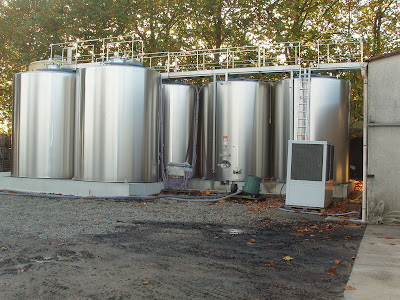 The stainless steel fermentation tanks
The stainless steel fermentation tanksThe next morning we visited the vineyards and the winery. Jean-Pascal showed me how his vines are planted to a very high density (7,000 vines/hectare) and how there are several subsoils in the Grand Fief de l’Audigère. The one under his plot is composed primarily of
gabbro (volcanic), resulting in a highly-perfumed, flowery wine that has a vibrant energy on a generous frame and beautiful natural acidity year-in and year-out, as I had discovered the previous evening. Talk about
terroir!
 Fermentation temperatures
Fermentation temperaturesRetracing the grapes’ steps, we made our way to the winery, where he showed me the stainless steel fermentation tanks as well as some glass-lined underground concrete tanks. That was new to me, as the only other concrete tanks I’d seen had been either naked (in the Rhône) or lined with epoxy (everywhere else). Two of the tanks had finished fermenting and the temperature gauges showed the differences: 13° and 14.5°C as opposed to the two which were still undergoing fermentation at 20.5° and 24°C. Usually, Jean-Pascal prefers to ferment at an average temperature of 20°C, which he feels maintains the crispness of the wine while also extracting the right amount of aromatics and flavors. The wine is left unfiltered to maintain the flavors.
 Underground tank
Underground tank Glass tiles on the interior wall of a tank
Glass tiles on the interior wall of a tankThen he brought out some glasses and we began tasting the 2008 Audigère that had ended fermentation. There’s nothing like tasting just-fermented Muscadet at 9am to slap you awake. Who need espresso? The wine was wild and still settling into itself, like a beautiful butterfly that is shaking the last vestiges of its cocoon off its new body. The acidity practically stripped the enamel off my teeth and left my mouth puckering. When this calms down, it will be lovely, despite the year. 2008 was a tough year, with a brutal frost in April that resulted in much lower yields (Jean-Pascal’s production is down 70% from previous years!). Still, with wise selection and careful winemaking, he feels he can make a very good wine this year. I agree, but as some of my friends happily point out, I am terribly biased.
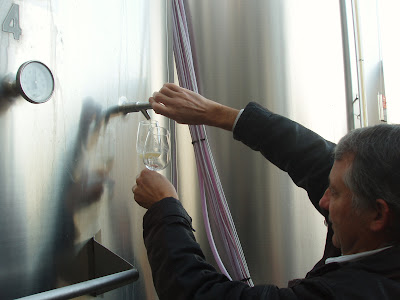 Tapping the just-fermented Muscadet
Tapping the just-fermented Muscadet Testing the density of the wine
Testing the density of the wine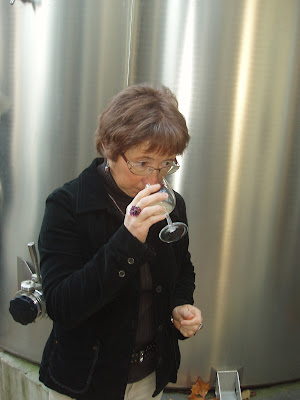 Madame likes what she smells
Madame likes what she smells Jean-Pascal looking happy with his 2008s
Jean-Pascal looking happy with his 2008s Scooping the regular Muscadet
Scooping the regular MuscadetWe moved on to his regular Muscadet de Sèvre et Maine sur Lie, which was quite different, with less of the aromatic oomph or zip of the Audigère. Very good but not great. He then reached into one of the underground tanks with a metal rod and scooped up some of his small-production Chardonnay (2.5 hectares). Nice, and very typical of Loire Chards, this won’t see any malolactic fermentation to maintain its sense of place. Crisp is the keyword here.
 Fishing for Chardonnay
Fishing for ChardonnayFinally we visited his Sauvignon Blanc, an experimental and small parcel (2.34 ha). I put my nose in the glass and had to take a step back: super aromatic, with huge notes of grass and herbal gooseberry (aka cat’s pee) on a strikingly fruity lemon frame, ending with mouth-puckering, almost painful acidity. Gorgeous, absolutely gorgeous, with an amazing presence on the palate, this wouldn’t let go even after I’d tasted. I told him if he bottled it, I’d take it all. This is some seriously delicious stuff.
 Old vine Melon de Bourgogne
Old vine Melon de BourgogneAfterwards, we had a lovely lunch in Nantes with some good and some bad wines (a sadly oxidized
2002 Luneau Papin Muscadet de Sèvre et Maine sur Lie Grand Fief de l’Audigère Sur Schist - he wanted to show me how the different
terroirs affect the same wine). Damn. Oh well. Then it was off to Cahors for a 6-hour train ride through the countryside.
I leave you with a little video of Muscadet fermenting, taken from the top of a fermentation tank after a vertiginious climb up a rickety ladder from which I nearly flopped off of. Enjoy. Oh, and that grunt? That's me sounding surprised at how much noise and movement are involved in fermentation.
Next: a weekend in the Cahors and visiting family.
Cheers!
